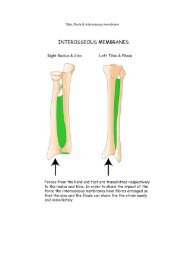GSM 11.11 version 6.2.0 - TTFN Smart card pages
GSM 11.11 version 6.2.0 - TTFN Smart card pages
GSM 11.11 version 6.2.0 - TTFN Smart card pages
- No tags were found...
You also want an ePaper? Increase the reach of your titles
YUMPU automatically turns print PDFs into web optimized ePapers that Google loves.
(<strong>GSM</strong> <strong>11.11</strong> <strong>version</strong> <strong>6.2.0</strong> Release 1997)10TS 100 977 V<strong>6.2.0</strong> (1999-05)[7] <strong>GSM</strong> 02.24: "Digital cellular telecommunications system (Phase 2+); Description of ChargeAdvice Information (CAI)".[8] <strong>GSM</strong> 02.30: "Digital cellular telecommunications system (Phase 2+); Man-Machine Interface(MMI) of the Mobile Station (MS)".[9] <strong>GSM</strong> 02.86: "Digital cellular telecommunications system (Phase 2+); Advice of charge (AoC)Supplementary Services - Stage 1".[10] <strong>GSM</strong> 03.03: "Digital cellular telecommunications system (Phase 2+); Numbering, addressing andidentification".[11] <strong>GSM</strong> 03.20: "Digital cellular telecommunications system (Phase 2+); Security related networkfunctions".[12] <strong>GSM</strong> 03.38: "Digital cellular telecommunications system (Phase 2+); Alphabets andlanguage-specific information".[13] <strong>GSM</strong> 03.40: "Digital cellular telecommunications system (Phase 2+); Technical realization of theShort Message Service (SMS) Point-to-Point (PP)".[14] <strong>GSM</strong> 03.41: "Digital cellular telecommunications system (Phase 2+); Technical realization ofShort Message Service Cell Broadcast (SMSCB)".[15] <strong>GSM</strong> 04.08: "Digital cellular telecommunications system (Phase 2+); Mobile radio interface layer3 specification".[16] <strong>GSM</strong> 04.11: "Digital cellular telecommunications system (Phase 2+); Point-to-Point (PP) ShortMessage Service (SMS) support on mobile radio interface".[17] <strong>GSM</strong> 09.91 (ETR 174): "Digital cellular telecommunications system; Interworking aspects of theSubscriber Identity Module - Mobile Equipment (SIM - ME) interface between Phase 1 andPhase 2".[18] CCITT Recommendation E.118: "The international telecommunication charge <strong>card</strong>".[19] CCITT Recommendation E.164: "Numbering plan for the ISDN era".[20] CCITT Recommendation T.50: "International Alphabet No. 5". (ISO 646: 1983, Informationprocessing - ISO 7-bits coded characters set for information interchange).[21] ISO/IEC 7810 (1995): "Identification <strong>card</strong>s - Physical characteristics".[22] ISO/IEC 7811-1 (1995): "Identification <strong>card</strong>s - Recording technique - Part 1: Embossing".[23] ISO/IEC 7811-3 (1995): "Identification <strong>card</strong>s - Recording technique - Part 3: Location ofembossed characters on ID-1 <strong>card</strong>s".[24] ISO 7816-1 (1987): "Identification <strong>card</strong>s - Integrated circuit(s) <strong>card</strong>s with contacts, Part 1: Physicalcharacteristics".[25] ISO 7816-2 (1988): "Identification <strong>card</strong>s - Integrated circuit(s) <strong>card</strong>s with contacts, Part 2:Dimensions and locations of the contacts".[26] ISO/IEC 7816-3 (1989): "Identification <strong>card</strong>s - Integrated circuit(s) <strong>card</strong>s with contacts, Part 3:Electronic signals and transmission protocols".[27] <strong>GSM</strong> 11.14 (TS 101 267): "Digital cellular telecommunications system (Phase 2+); Specificationof the SIM Application Toolkit for the Subscriber Identity Module - Mobile Equipment (SIM -ME) interface".[28] <strong>GSM</strong> 11.12: "Digital cellular telecommunications system (Phase 2); Specification of the 3 VoltSubscriber Identity Module - Mobile Equipment (SIM - ME) interface".ETSI








